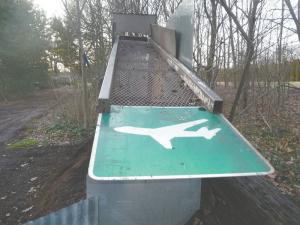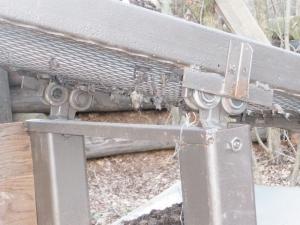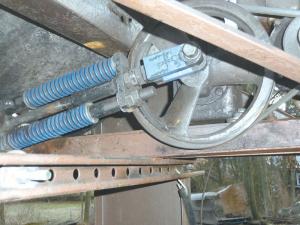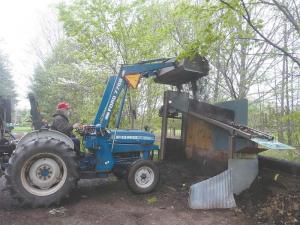2017 - Volume #41, Issue #3, Page #26
[ Sample Stories From This Issue | List of All Stories In This Issue | Print this story
| Read this issue]
Loader Bucket-Sized Compost Sifter
 |
 |
 |
 |
“It took me 45 min. to sift out a wheelbarrow full of compost and a lot of shoveling,” says Stremlo. “We need 2 or 3 tons of compost to build new garden beds. Now I do a loader bucket full in a few minutes.”
Stremlo’s sifter is 2 ft. wide and 12 ft. long. It’s mounted on a frame made from old goal posts and steel tubing. Uprights at the upper end where the engine sits were salvaged from an old mobile home trailer tongue.
The sifter was designed to leave room underneath it for the loader to retrieve a bucketful. The lower end of the screen leaves room for a wheelbarrow to be pushed underneath it to collect larger particles and materials not fully composted. They are wheeled back to the composting pile.
“I’ve found the returns speed up the composting process,” says Stremlo.
Most of the sifter was recycled from one use or another, but the motor with factory installed gear reducer was actually fresh out of the box. Stremlo purchased it at a yard sale. He later found out that it sat on a shelf for 20 years.
“I put gas and oil in it, and it started right up,” he says.
The screen is slotted, expanded mesh with an overlay of “rat wire” (hardware cloth). Stremlo added the hardware cloth to reduce the hole size and resulting particle size. The screen frame rides on plastic wheels that are mounted to uprights on the main frame.
The sifting screen moves up and down at an angle, with finished compost sifting through and large scraps needing more time in the compost pile falling off the end.
The sifter is powered by a 3 1/2 hp. motor with a built-in 6-to-1 gear reducer. The output shaft with a small sheave drives a larger old cast iron sheave on an old air compressor pump. This reduces the output shaft speed even more.
As the air compressor pump’s only purpose is to provide a housing for the drive sheave, Stremlo removed the pistons and rod and filled the compressor with oil. He drilled a 3/8-in. hole in the arms of the cast iron sheave 3/4-in. from the center of the shaft and installed a grade-8 bolt in the hole.
Once the offset bolt was connected to the screen, it provided about 1 1/2 in. of lateral movement with every revolution.
The connecting arm is a set of shock absorber type springs from an old conveyer dishwasher. “One spring in the pair regulates how hard it pushes the screen downhill, and the other regulates how hard it pulls the screen back up the slope,” says Stremlo. “When the screen slides downhill, the engine has to work hard pulling it back up. The spring reduces that effort.”
Stremlo notes that his sifter isn’t quite finished. If he dumps raw compost onto the screen too fast, it can stop the screen in its tracks.
“The answer may be to mount a hopper from a pickup-mounted salt spreader,” says Stremlo. “It would better regulate how fast compost drops onto the screen.”
Meanwhile Stremlo remains satisfied with his design and its price tag. “I only have about $200 in it, and half of that was for the paint I used,” says Stremlo. “I did a good job painting it when it was new.”
Check out a video of Stremlo’s compost sifter at FARMSHOW.com.
Contact: FARM SHOW Followup, Brook Hollow Farm (ph 732 947-2778; jstremlo@gmail.com).

Click here to download page story appeared in.

Click here to read entire issue
To read the rest of this story, download this issue below or click here to register with your account number.




